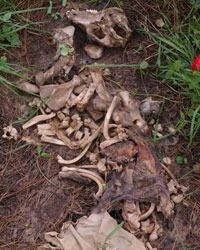Police officers who arrive at fatal crime scenes will be better prepared to gather evidence after participating in an unusual training experiment with members of the university’s forensic sciences program.
“It’s a great learning experience for my officers,” Sgt. Doug Cowper of the Windsor Police Service’s forensic identification branch said yesterday, just before he and some of his colleagues got to the gruesome task of exhuming several dead pigs that had been buried behind the police training facility on Sandwich Street.
“We’re the first ones to discover a crime scene, so knowing what to look for and how to recover it is very important,” said Cowper, who oversees a branch of eight forensic constables, a DNA expert and a fingerprint specialist. “This helps our officers stay fresh and to know what it is they’re supposed to do when they collect evidence.”
The pigs were part of an experiment overseen by Sherah VanLaerhoven, an associate professor in biology and academic chair of the forensic sciences program. In mid-August, nine dead pigs were shot at close range through cotton panels that were attached to their bodies. Six of those pigs were buried, while the other three were left to decompose above ground in a large weed patch.
|
The experiment is part of an undergraduate research project being conducted by fourth year student Nick Cercone, who is working in cooperation with the Centre for Forensic Sciences in Toronto. After the cloth panels are retrieved, they’re soaked in a chemical solution to test for residual nitrates, which helps forensic identification officers determine how far the muzzle of the gun was from the victim when it was fired. Cercone, who aspires to be a police officer, is testing to see how varying levels of decomposition affect their ability to determine that distance. He hopes to publish the results of his study in an academic journal. |
Remains of one of the pigs left to decompose on the surface are seen here. |
The experiment also provided an opportunity for Dr. VanLaerhoven to share some of her expertise on forensic entomology with local police officers. Certain types of insects colonize dead bodies at various times throughout the process of decomposition and by studying which bugs are present when a body is exhumed, she can accurately predict how long the it’s been there. During yesterday’s exhumation, she taught some of those officers about collecting insect evidence.
“If officers come across a clandestine grave or scattered remains, they need to know what to do with them,” said VanLaerhoven, who teaches a course on recovering human remains at the Ontario Police College in Aylmer.
Pigs are used for the experiment because they have similar skin to humans and decompose at about the same rate, said VanLaerhoven, who added that the experiment provided her with a chance to build her data base of insects known to colonize decomposing bodies.


